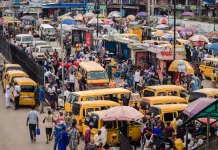
The World Bank adjusts its 2024 economic growth projection for sub-Saharan Africa, bringing it down to 3% from its earlier estimate of 3.4%, mainly due to the impact of the civil war in Sudan.
Despite this downgrade, the region is still set to grow faster than last year’s 2.4%, driven by rising private consumption and investments, as highlighted in the latest Africa’s Pulse report.
“This is still a recovery in slow motion,” remarks Andrew Dabalen, the World Bank’s Chief Economist for Africa, during a media briefing on Monday. The report forecasts that growth will climb to 3.9% in 2025, up from the previous estimate of 3.8%, thanks to easing inflation rates in many countries, which could enable central banks to lower high interest rates.
Despite the projected recovery, the report emphasizes that armed conflicts, climate disasters like droughts and floods, and political instability pose significant risks to the region’s economic outlook. Without the devastating effects of Sudan’s ongoing conflict, the region’s 2024 growth would have been half a percentage point higher.
- South Africa, the region’s largest economy, is projected to grow by 1.1% this year and 1.6% in 2025, following a 0.7% growth rate last year.
- Nigeria’s economy is forecasted to expand by 3.3% in 2024 and further accelerate to 3.6% in 2025.
- Kenya, East Africa’s biggest economy, is expected to grow by 5% in 2024, according to the report.
The region’s economy grew robustly between 2000 and 2014, averaging 5.3% annually during the global commodity boom. However, growth slowed significantly after the crash in commodity prices and the COVID-19 pandemic.
“If this economic stagnation continues, the effects will be catastrophic,” warns Dabalen.
Dabalen also points out that many African economies are struggling with low levels of public and private investments. While foreign direct investments (FDI) began to recover in 2021, they remain weak.
“The region needs much higher investment levels to accelerate recovery and fight poverty,” he says. Debt service costs are also a major hurdle in countries like Kenya, where protests erupted earlier this year over rising taxes. Many African governments have moved away from cheaper loans from institutions like the World Bank, turning instead to costlier borrowing from financial markets.
- The region’s external debt has soared to around $500 billion, up from $150 billion 15 years ago, with much of it owed to bondholders and China.
- Countries such as Chad, Zambia, Ghana, and Ethiopia have defaulted in recent years and have since restructured their debts under the G20’s Common Framework. Ethiopia’s restructuring is still ongoing, while the other nations have completed the process.
“As long as these debt challenges remain unresolved, uncertainty will persist, which is bad for both countries and creditors,” Dabalen notes.
The World Bank also projects that over the next three decades, sub-Saharan Africa will experience the fastest growth in its working-age population globally, with an increase of 740 million people by 2050. However, with 12 million young people expected to enter the workforce annually, and only 3 million formal wage jobs being created each year, the region faces significant economic challenges moving forward.













